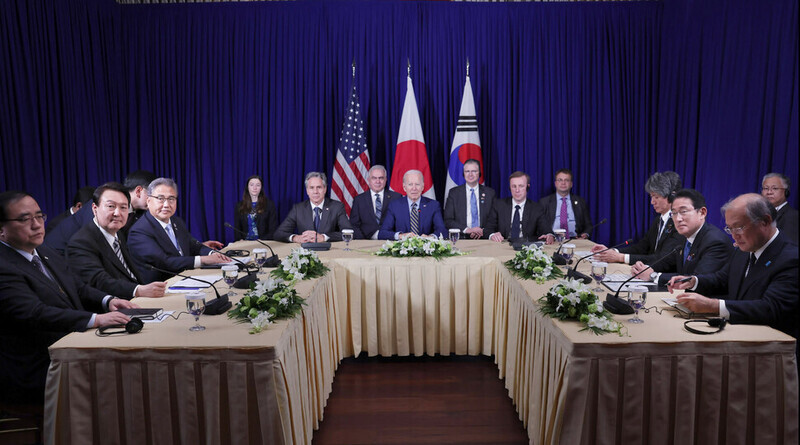hankyoreh
Links to other country sites 다른 나라 사이트 링크
[Column] Korea shouldn’t be welcoming Japan’s pursuit of counterstrike capabilities


Japan’s ruling Liberal Democratic Party (LDP) and its junior coalition partner, Komeito (KM), have agreed to pledge to acquire a “counterstrike capability” that shows that they have the power to attack its enemy’s missile bases.
Japan introduced its comprehensive missile defense plan for the first time in 2013, when then-Prime Minister Shinzo Abe declared the right to collective self-defense in the national security strategy, which paved the way for overseas expeditionary operations.
Abe announced in September 2020 that Japan would not just enhance its interception capability to defend itself from missile threats, but also would have the capacity to counter enemy missiles.
Since the phrase “striking enemy bases” could imply that Japan would proceed with preemptive strikes against China or North Korea, the phrase has been changed to “counterstrike capability” under Prime Minister Fumio Kishida’s administration.
Three policy documents, including Japan’s national security strategy, will be revised this month. They will adopt this “counterstrike capability” as an official policy and draw up detailed plans to possess attack missiles.
According to information obtained so far, Japan will buy 500 Tomahawk cruise missiles from the US, expand the range of surface-to-ship missiles by 1,000 kilometers, deploy high-speed glide weapons for the defense of remote islands, and deploy hypersonic glide vehicles with a maximum range of 3,000 kilometers in the 2030s.
No matter how many missiles there are, they are useless if they cannot find a target. The Japanese government is planning on launching dozens of ultra-small cluster satellites into low Earth orbit to find where China and North Korea will target.
The entire Korean Peninsula will be under both Japan’s surveillance and missile range, a puzzling arrangement.
The concept of Japan’s exclusively defense-oriented policy according to its pacifist constitution has long been clearly defined. For instance, even if it’s necessary for the country’s defense, a preemptive strike on another country is not allowed and an invading enemy attack can only be repulsed by military force on Japanese territory. Given this definition, if an enemy located thousands of kilometers away is attacked with missiles by Japan, this principle would obviously be nullified.
Regarding this issue, the Japanese government will use the logic of collective self-defense, arguing that it would only use its missile attack capabilities at the request of the US, in case of urgent need.
This position is also closely based on the US’ own strategic calculations. Four years ago, former US President Donald Trump withdrew from the Intermediate-Range Nuclear Forces Treaty (INF) signed with Russia.
Soon after, the US sought Asian countries to deploy ground-based intermediate-range missiles with the aim of containing China, but South Korea and the Philippines were not on board and Australia was too far from China, making it an ineffective option. However, the US and Australia did agree to the joint development and test launching of hypersonic cruise missiles.
Given this conundrum, US strategists concluded that the most effective approach would be to help Japan acquire its own intermediate-range missiles instead of deploying US missiles to Asian countries, many of which have concerns about souring their relations with China.
A report titled “Ground-Based Intermediate-Range Missiles in the Indo-Pacific: Assessing the Positions of U.S. Allies” published by the Rand Corporation in April includes an entire section proposing how to support Japan’s standoff missile capabilities.
It was also at this time that Japan’s ruling LDP announced the counterstrike capability proposal which would no longer be limited to missile bases of other countries but would also include the command and control functions of enemy countries. This example shows how American strategists and Japanese politicians are working hand in glove.
Japan’s possession of offensive military capabilities would completely neutralize its pacifist constitution and serve as a stepping stone for Tokyo to earnestly join in the competition with China for supremacy in East Asia.
Although it does view the North Korean nuclear missile threat as serious, Japan has been seeing China as the “main threat” since the publishing of its 2018 defense white paper. By doing so, it is earnestly challenging great power politics.
If Japan, which has kept a low military profile since World War II, now rises up as a regional military powerhouse and employs a grand strategy, it could have destabilizing effects for East Asia as a whole.
Whether aware of this or not, President Yoon Suk-yeol suddenly agreed at a South Korea-US-Japan trilateral summit with US President Joe Biden and Japanese Prime Minister Fumio Kishida in Phnom Penh, Cambodia, last month that the three countries should “share missile information in real time.”
In addition, in a recent interview with Reuters, the South Korean president practically accepted Japan's arms buildup, saying, "I believe the Japanese government cannot be asleep at the wheel with the North Korean missile flights over their territory.”
This means that South Korean military intelligence could be used for a potential Japanese attack against North Korea.
The problem, however, is that it remains unclear under what exact conditions Japan would use such offensive capabilities. Yoon’s stance also contradicts the long-held South Korean government position that “Japan should transparently strengthen its defense capabilities in a way that contributes to regional stability while complying with its pacifist constitution."
Since the Yoon Suk-yeol government is offering no explanations or convincing arguments regarding this very important issue, my anxiety simply continues to grow.
Please direct questions or comments to [english@hani.co.kr]

Editorial・opinion
![[Column] Has Korea, too, crossed the Rubicon on China? [Column] Has Korea, too, crossed the Rubicon on China?](https://flexible.img.hani.co.kr/flexible/normal/500/300/imgdb/original/2024/0419/9317135153409185.jpg) [Column] Has Korea, too, crossed the Rubicon on China?
[Column] Has Korea, too, crossed the Rubicon on China?![[Correspondent’s column] In Japan’s alliance with US, echoes of its past alliances with UK [Correspondent’s column] In Japan’s alliance with US, echoes of its past alliances with UK](https://flexible.img.hani.co.kr/flexible/normal/500/300/imgdb/original/2024/0419/2317135166563519.jpg) [Correspondent’s column] In Japan’s alliance with US, echoes of its past alliances with UK
[Correspondent’s column] In Japan’s alliance with US, echoes of its past alliances with UK- [Editorial] Does Yoon think the Korean public is wrong?
- [Editorial] As it bolsters its alliance with US, Japan must be accountable for past
- [Guest essay] Amending the Constitution is Yoon’s key to leaving office in public’s good graces
- [Editorial] 10 years on, lessons of Sewol tragedy must never be forgotten
- [Column] A death blow to Korea’s prosecutor politics
- [Correspondent’s column] The US and the end of Japanese pacifism
- [Guest essay] How Korea turned its trainee doctors into monsters
- [Guest essay] As someone who helped forge Seoul-Moscow ties, their status today troubles me
Most viewed articles
- 1[Column] The clock is ticking for Korea’s first lady
- 2After 2 months of delayed, denied medical care, Koreans worry worst may be yet to come
- 3US overtakes China as Korea’s top export market, prompting trade sanction jitters
- 4[Column] Has Korea, too, crossed the Rubicon on China?
- 5[Correspondent’s column] In Japan’s alliance with US, echoes of its past alliances with UK
- 6Hong Se-hwa, voice for tolerance whose memoir of exile touched a chord, dies at 76
- 7[Editorial] When the choice is kids or career, Korea will never overcome birth rate woes
- 8Samsung barricades office as unionized workers strike for better conditions
- 9All eyes on Xiaomi after it pulls off EV that Apple couldn’t
- 10More South Koreans, particularly the young, are leaving their religions